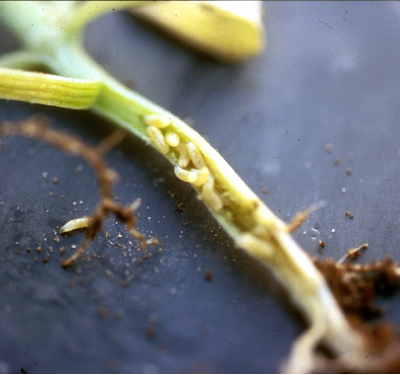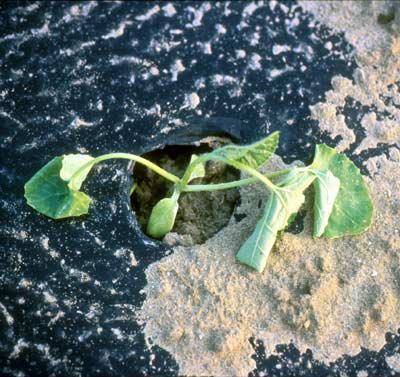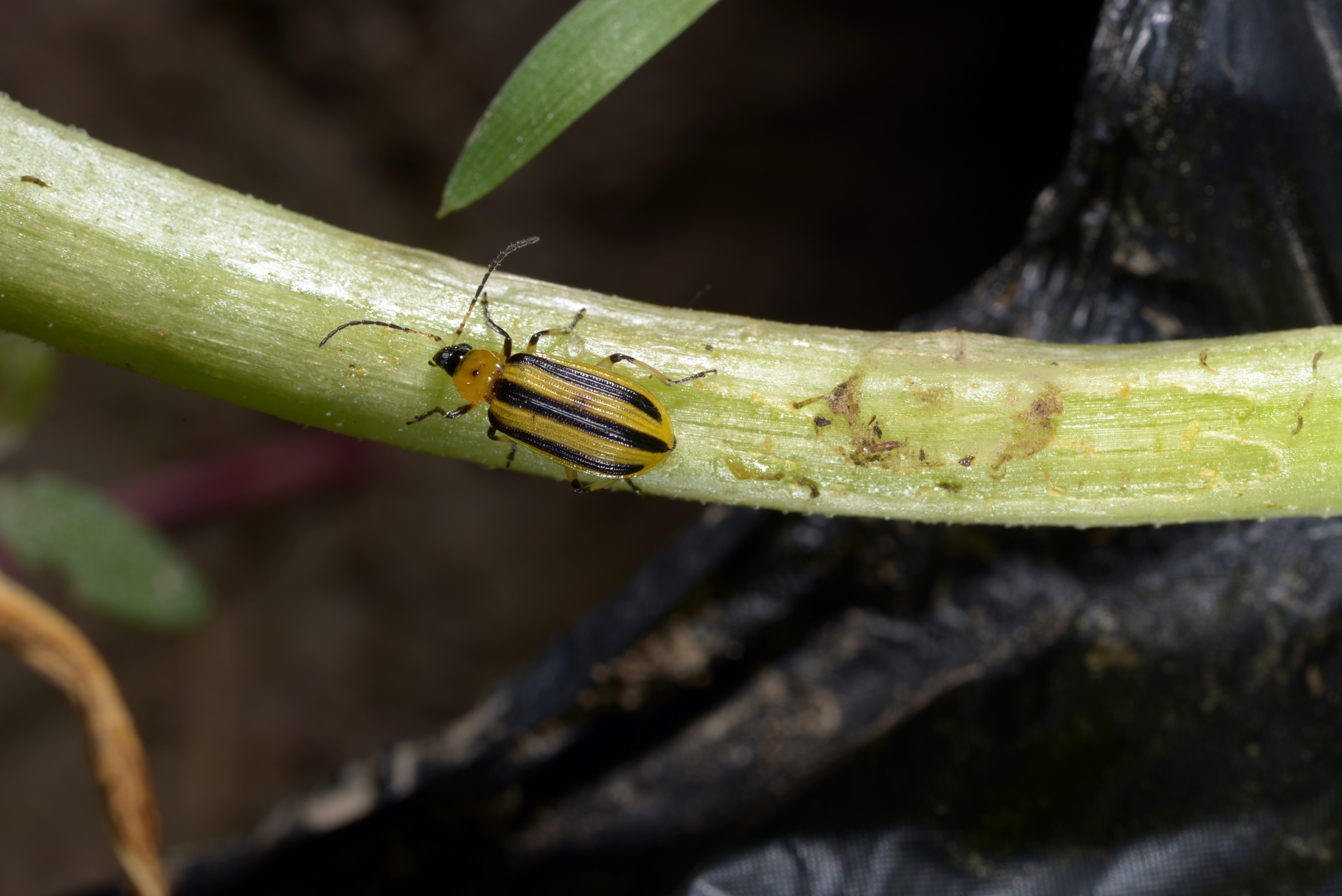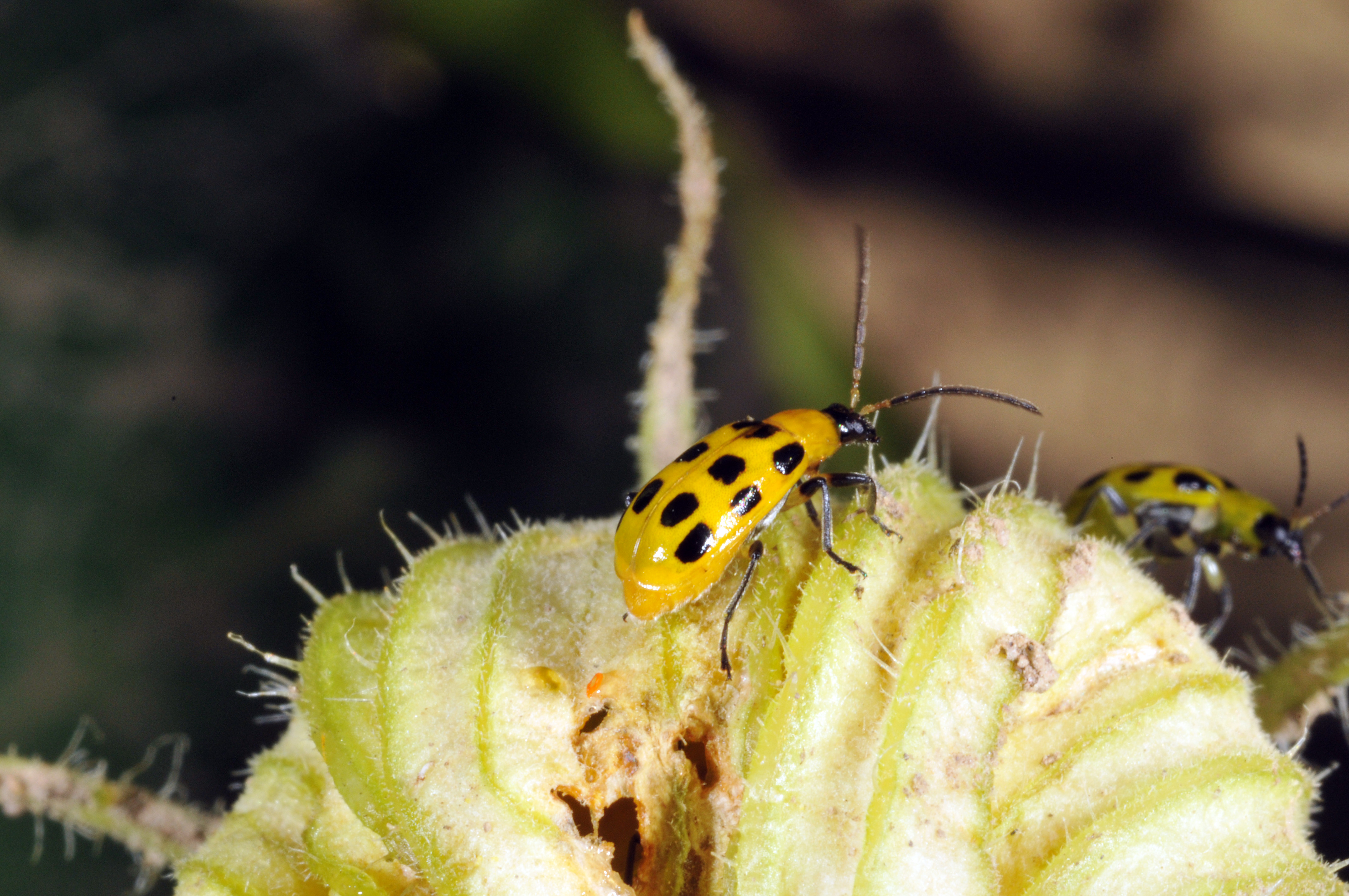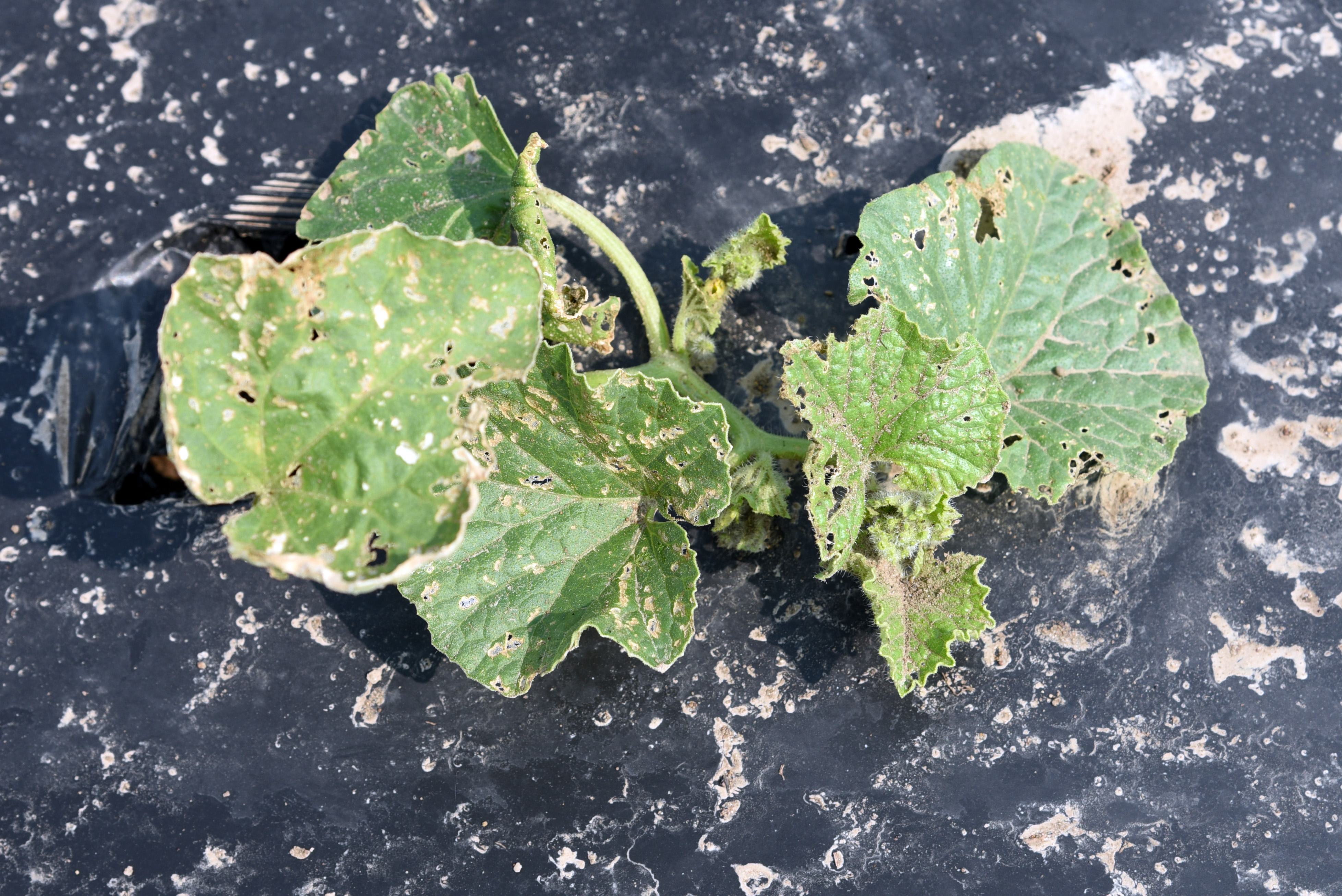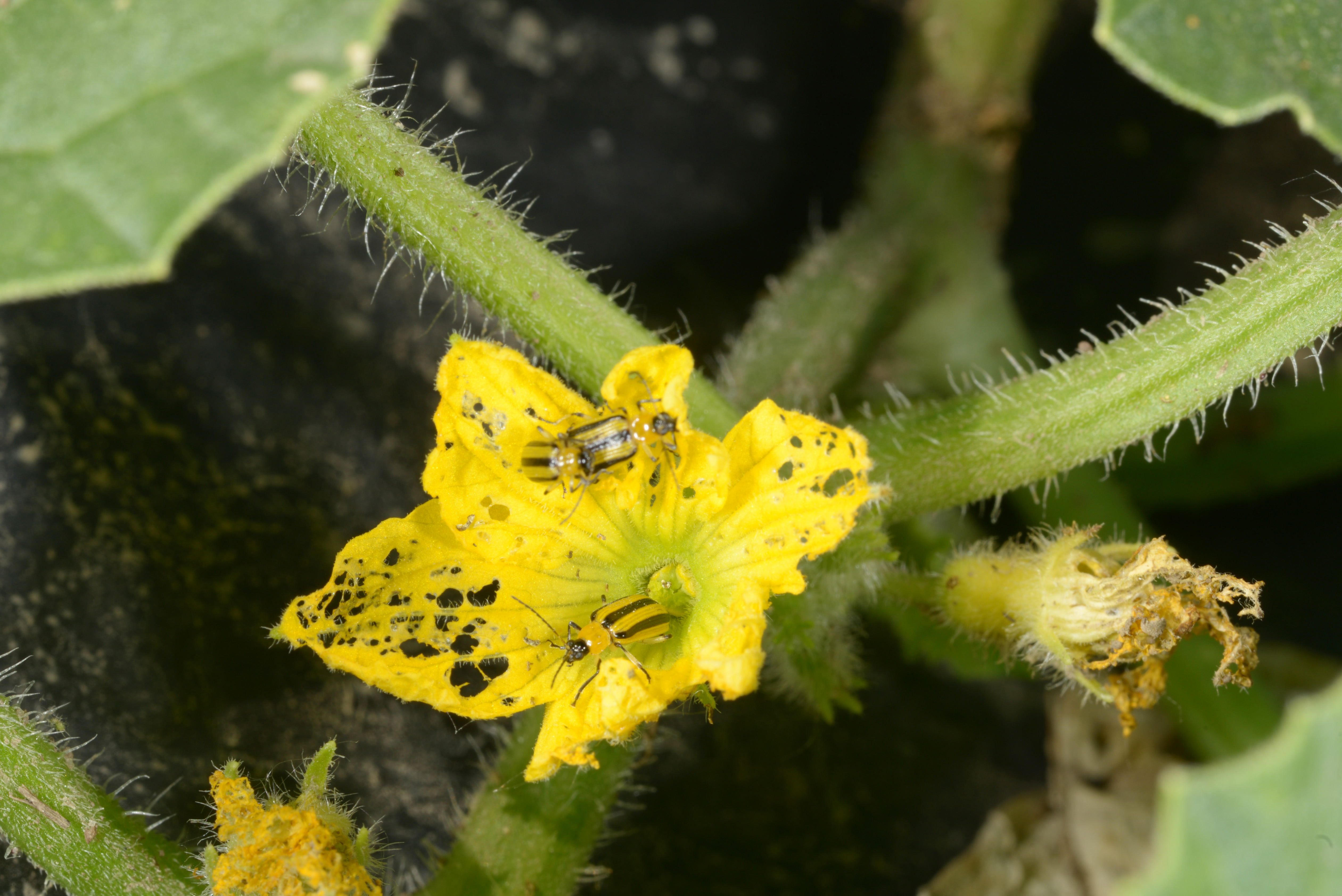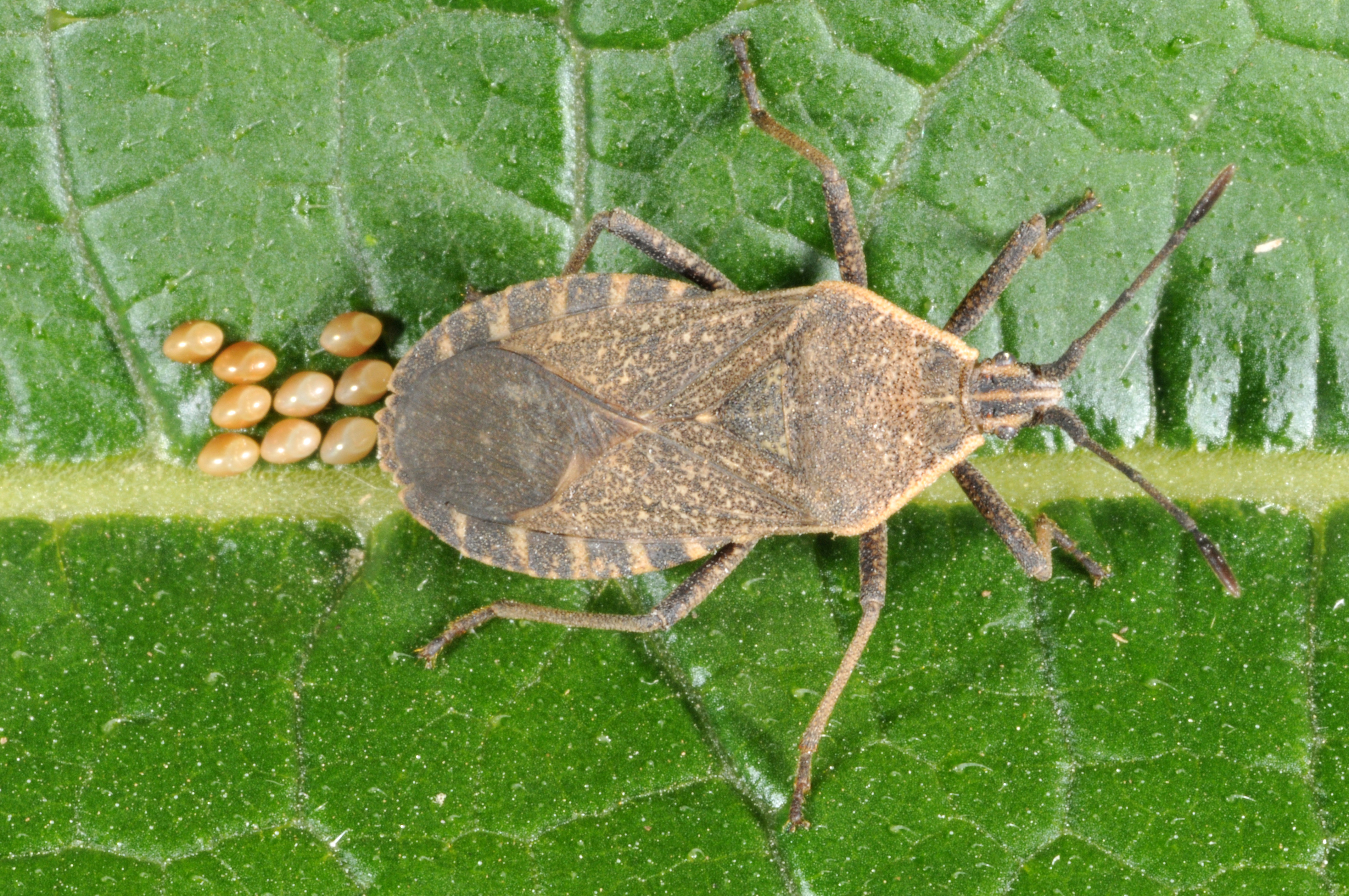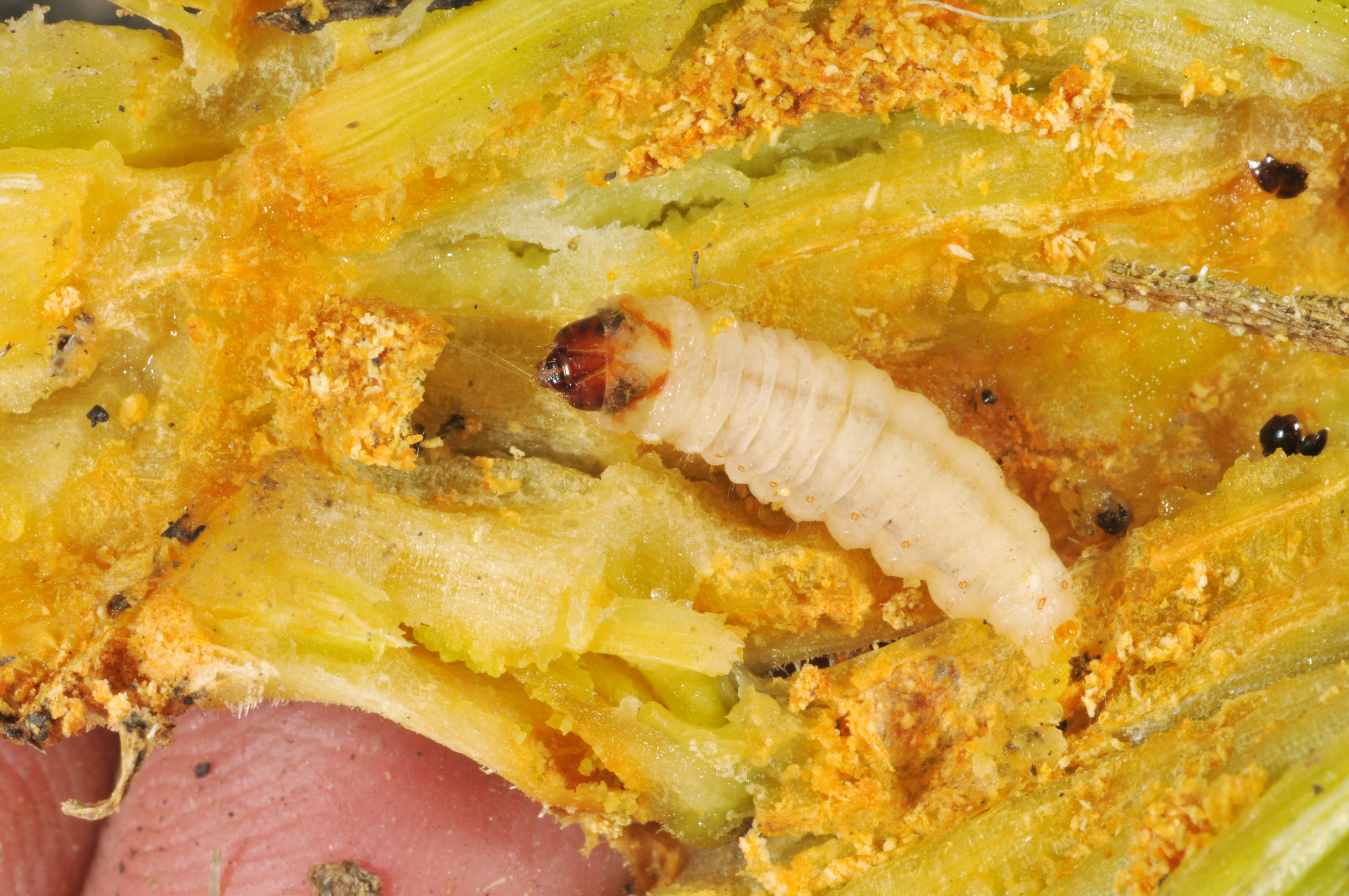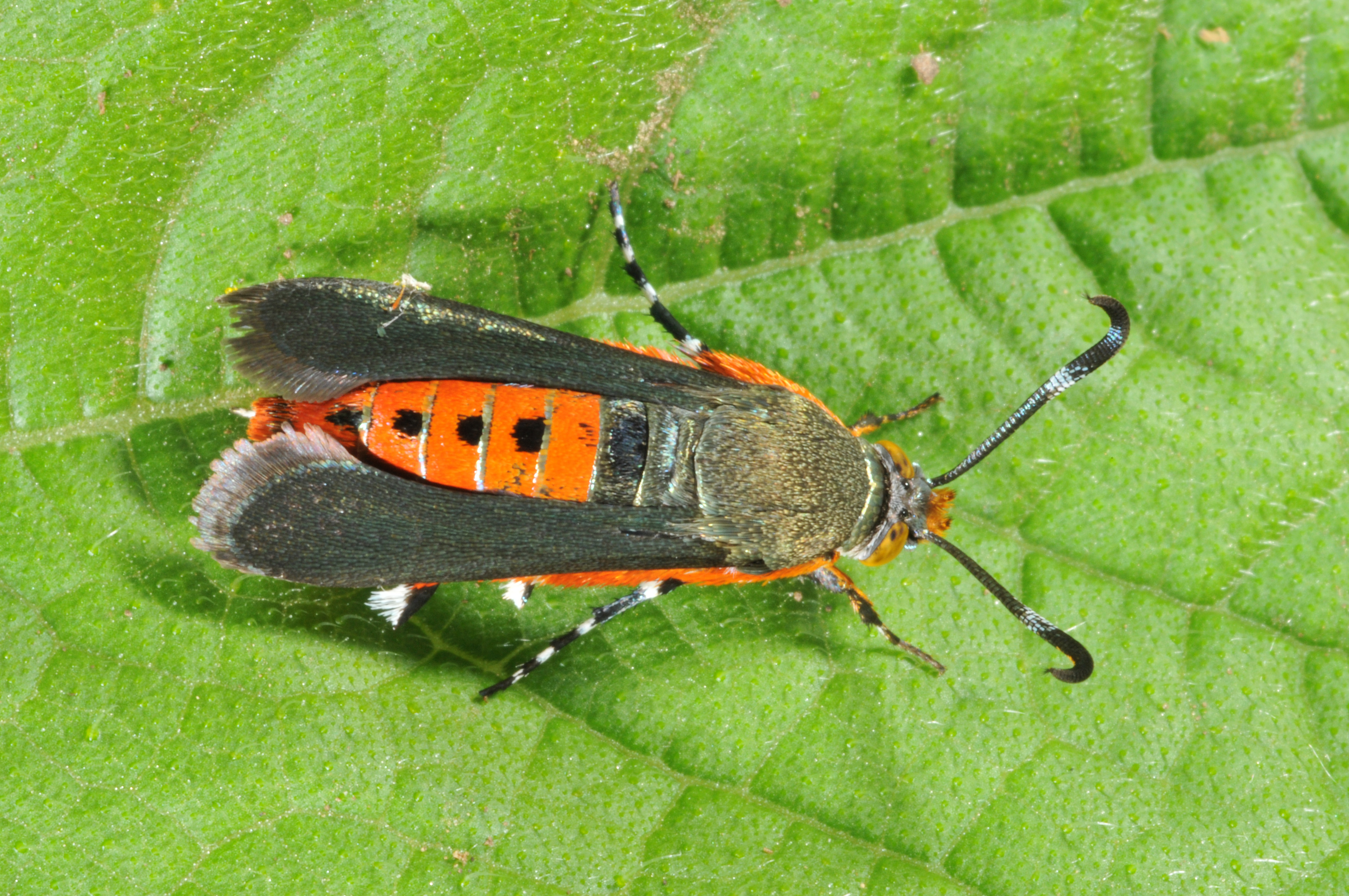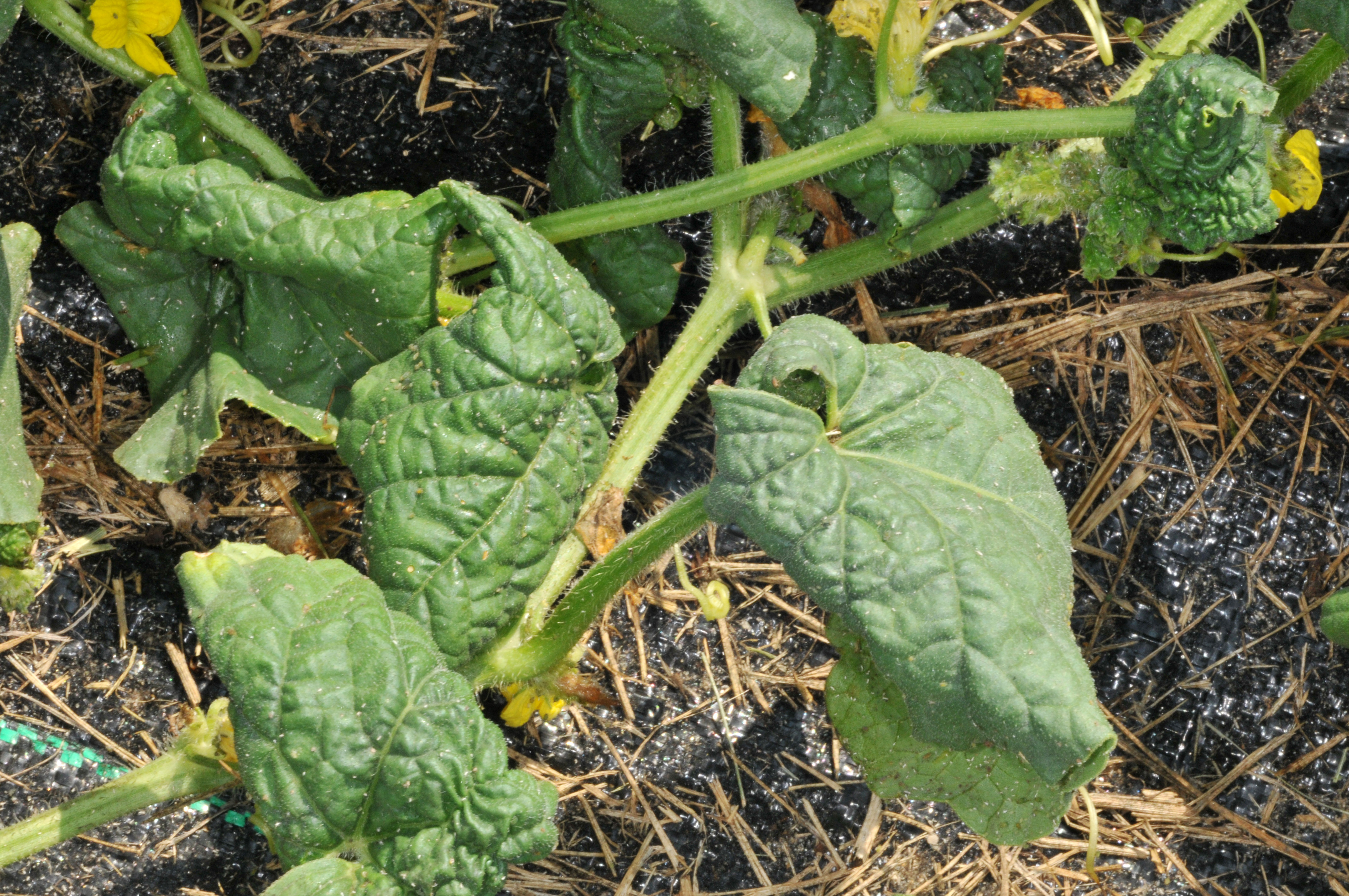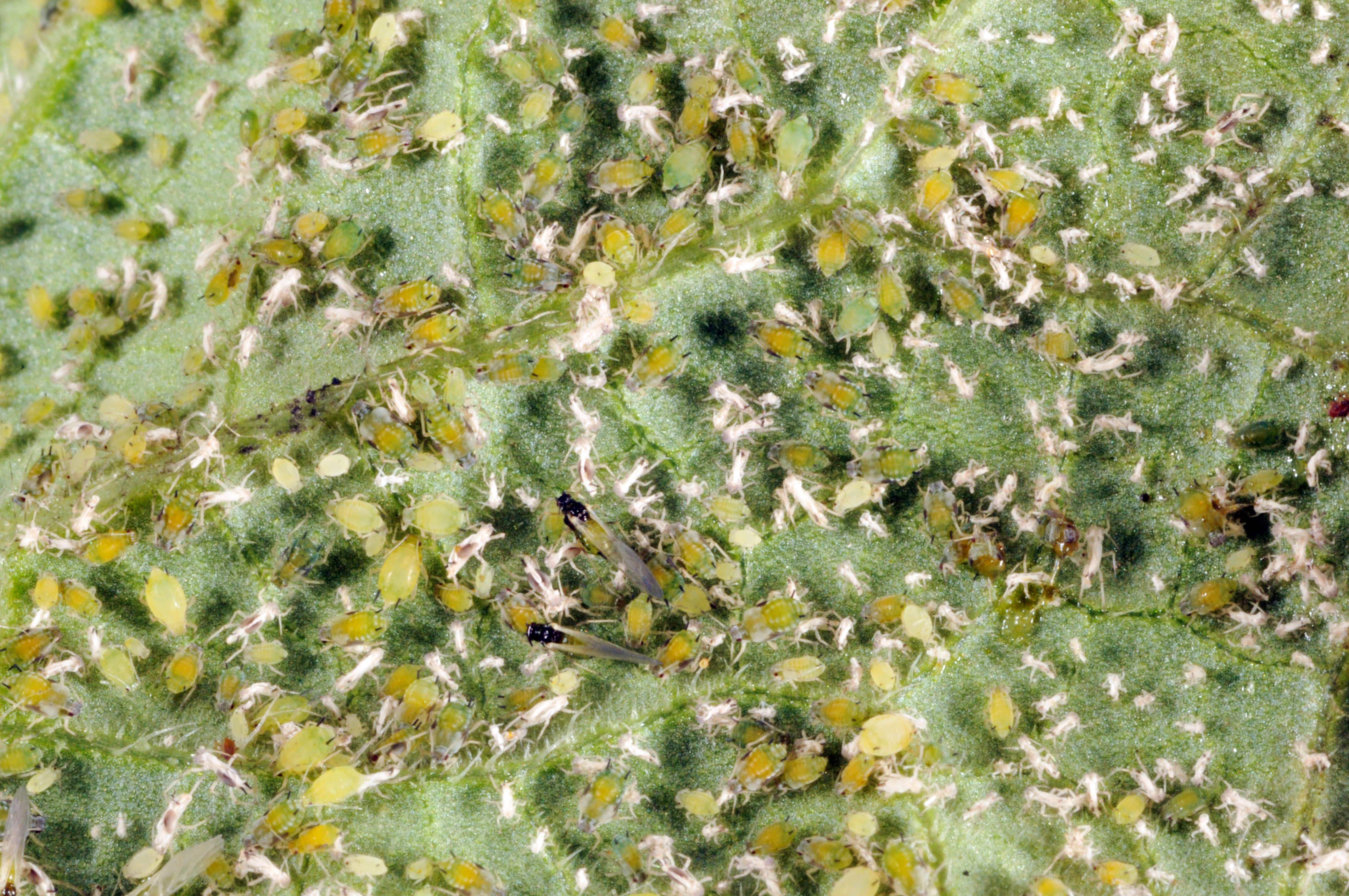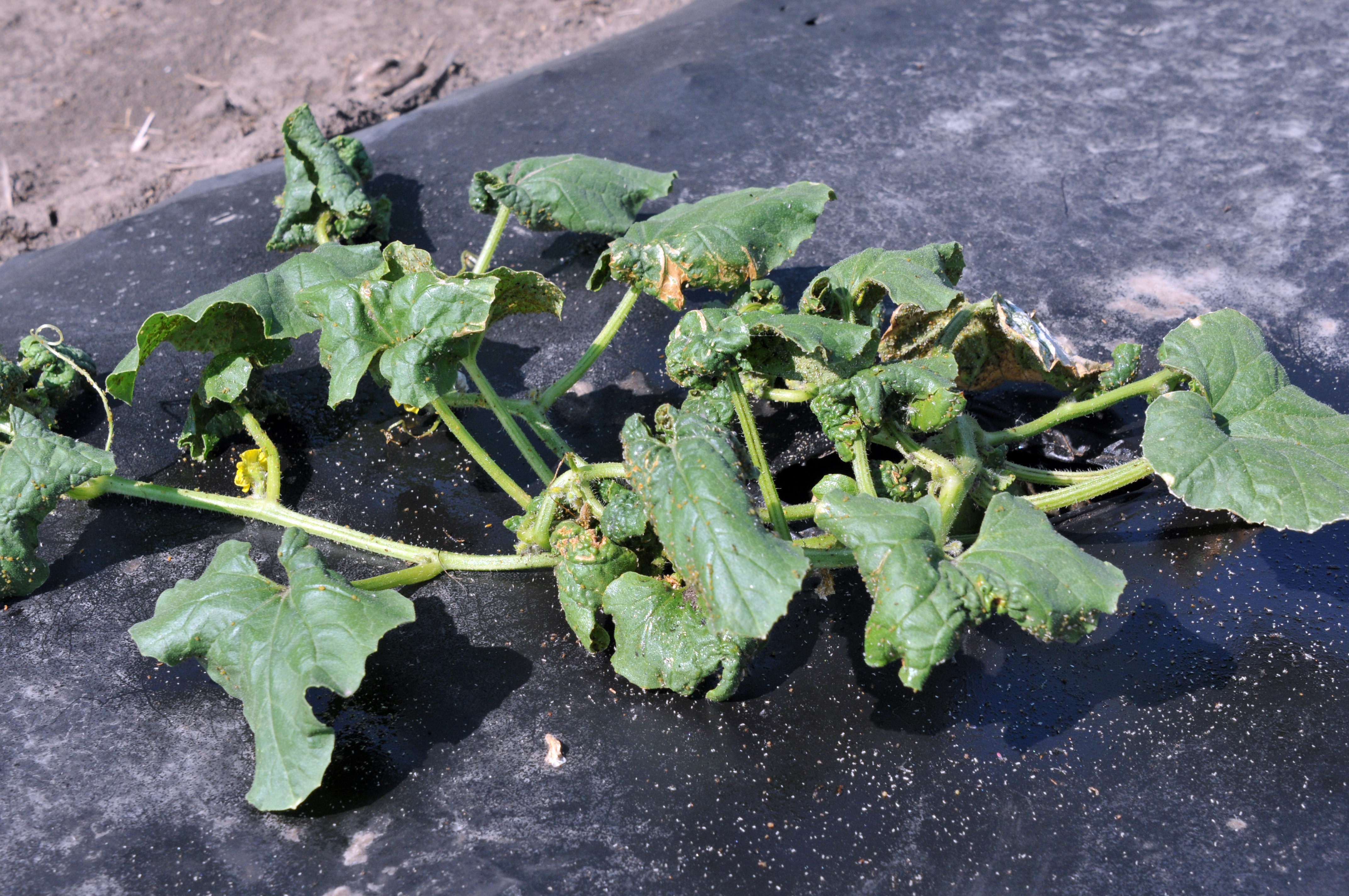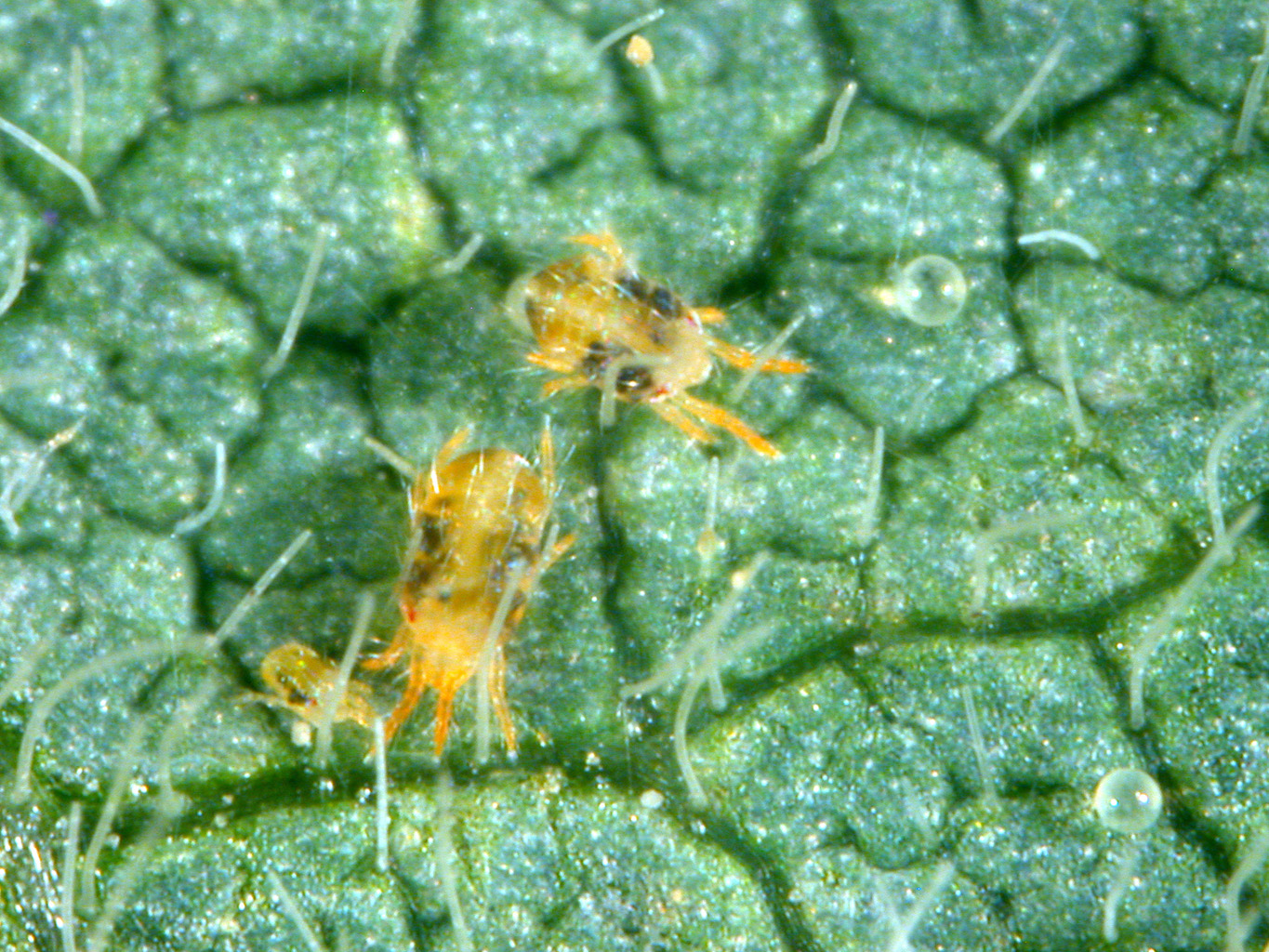Vegetable Insects
CUCURBIT INSECT MANAGEMENT
Ricky E. Foster, Extension Entomologist
If you want to view as pdf, click here
Muskmelons, watermelons, cucumber, squash, gourds, and pumpkins are cucurbits commonly grown in Indiana. These crops, are attacked by a variety of insects and related pests, including aphids, cucumber beetles, seedcorn maggot, squash bug, squash vine borer, and twospotted spider mite.
Scouting a field to estimate the number of pests present is an important component of effective management. The field should be scouted in a “Z” pattern. For each 20-acre field, at least 10 plants in 10 locations should be checked. Cucumber beetles, aphids, and twospotted spider mite usually infest at the field border first and then move into the field.
SEEDCORN MAGGOT
Type of Injury
The maggots or larvae bore into the seeds, often destroying the germs, and into seedlings. Damage may include seeds not germinating or plant being stunted, wilting, or dying within a few days.
Cucurbits Attacked
Early-planted melons and cucumbers are most likely to be attacked by seedcorn maggots.
Life History
The maggots overwinter inside a dark-brown, capsule-like puparium in the soil. Adults appear in the fields in early April. Adults are similar to house flies, grayish-brown and about 1/5 inch long. The flies lay their eggs in moist soil where there is an abundance of decaying vegetable matter. The eggs hatch at soil temperatures about 50°F. The maggots are yellowish-white, legless, and about 1/4 inch long when fully grown. Cool, wet periods favor the development of the maggots. The maggots pupate in the soil. The life cycle can be completed in about 3 weeks. There are 3 to 5 generations per year, depending on latitude, but the first generation is economically most important.
Seedcorn maggots and damage to muskmelons
(Photo Credits: G. Brust)
Time for Scouting
Scout the field after crop is set until early June.
Management Options
Plow Cover Crop Early
Plow down the cover crop at least 3 to 4 weeks before planting. Melons or cucumbers that are planted in the fields of any cover crop that is disked shortly (<3 weeks) before planting are at increased risk of seedcorn maggot attack.
Treated Seed
The insecticide used in FarMore treated seed is unlikely to reduce damage from seedcorn maggot.
Plant into Warm Soil
If possible, avoid planting muskmelons under cool, moist conditions. Plant or transplant cucurbits after soil temperatures reach about 70°F at 4-inch depth for at least 3-4 days.
Soil Insecticide at Planting
Admire Pro and Platinum applied at planting are not labeled for use on seedcorn maggots, and are unlikely to provide much control.
Replace Transplants
If the maggots are <1/4 inch long, replant after 10 days. If the maggots are >1/4 inch long, replant after 5 days.
CUCUMBER BEETLES
Type of Injury
The adults feed on the cotyledons, leaves, vines, blossoms, and the rind of fruits. The beetles are vectors of the bacterium that causes bacterial wilt of muskmelons and cucumbers. The larvae feed on roots and tunnel in underground stems, although this damage is usually not very important.
Cucurbits Attacked
Cucumber beetles attack muskmelons, watermelons, cucumbers, squash, gourds, and pumpkins.
Life History
Striped Cucumber Beetle
Unmated adults overwinter in the leaf litter of neighboring woodlands. The adults emerge from hibernation in early April and appear in cucurbit fields soon after the plants are set or germinated. The beetle is yellowish-green, about 1/5 inch long, and 1/10 inch wide. The beetle has three black stripes along the length of the body and a black abdomen. The western corn rootworm beetle also has three black stripes along the body, but it has a yellow abdomen. The western corn rootworm causes no economic damage to the cucurbits.
After the overwintered beetles migrate to the crops, they mate, and the females lay eggs in the soil and at the base of the plants. The yellow, oval eggs hatch in 5-8 days. The white larvae feed on the roots for 2-3 weeks and pupate underground. The new adults appear from late June to mid-July and remain active until fall.
Spotted Cucumber Beetle
The spotted cucumber beetle is also known as the southern corn rootworm beetle. The beetle is greenish-yellow and has 12 spots on the wing covers. The adults appear in cucurbit fields during late June to mid-July. The adults feed on leaves and blossoms and also vector bacterial wilt. The beetles cannot overwinter in northern areas, and they migrate from southern states each year. The insect has 1 to 2 generations per year, depending on latitude.
Striped cucumber beetle and spotted cucumber beetle
(Photo Credits: J. Obermeyer)
Striped cucumber beetle damage to leaves and fruit
(Photo Credits: (J. Obermeyer)
Transmission of Bacterial Wilt
Muskmelons and cucumbers are susceptible to bacterial wilt, but watermelons, squash, and pumpkins are not. The bacterium that causes the disease is transmitted to the plants during the feeding of the cucumber beetles. The bacteria multiply in the water-conducting vessels of the plant and stop the flow of water, resulting in sudden and permanent wilt of a vine or the entire plant. The symptoms appear 2-6 weeks after the plant is infected. Once a plant is infected with the bacterium, nothing can be done to save the plant. The management tactic for the disease is to prevent the beetle feeding on the plants.
Time for Scouting
Scout the field after the crop is set to early June and from early July to mid-August. Be aware that large numbers of beetles may invade your fields over a short period of time. Beetles will usually congregate on plants near the field edges first. For more detailed information on scouting, see "Monitoring and Decision Making for Cucumber Beetles on Muskmelon" at http://extension.entm.purdue.edu/publications/E-101.pdf.
Management Options
Striped and spotted cucumber beetles in cucurbit fields are managed collectively.
Treated Seed
For direct seeded crops, the insecticide in FarMore treated seeds will provide about 3 weeks of control of striped cucumber beetles.
Soil Insecticide at Planting
Using Admire Pro or Platinum at planting will control beetles for about 3 weeks. The lowest labeled rate gives control equal to higher rates. Foliar insecticides will also be needed later even if a soil insecticide is used.
Scout the Field
Scout the fields as soon as seedlings emerge or transplants are set. Beetles tend to congregate on the plants along the borders during the early season. Sample the field borders 2-3 times a week. Once beetles are found on several scattered plants along the field edges, scout the entire field. If the population reaches the economic threshold, treat the whole field. The influx of beetles into the field will last for 2-4 weeks. After this period, sample the field weekly, and treat the field only when the beetle population exceeds the threshold.
Use Economic Thresholds
For muskmelons and cucumbers, the economic threshold (the insect number at which foliar insecticides should be used) is 1 beetle/plant, whereas for watermelons, squash, and pumpkin, the economic threshold is 5 beetles/plant.
Foliar Insecticides
Insecticides recommended for the control of cucumber beetles are Ambush, Asana, Assail, Baythroid, Belay, Brigade, Danitol, Mustang Maxx, Pounce, Sevin, or Warrior.
SQUASH BUG
Type of Injury
Both nymphs and adults suck the plant sap from leaves and vines. The leaves become black and crisp, and the plant wilts and eventually dies. In the late season, squash bugs may feed on the fruit, and may make them unmarketable. Squash bugs are also suspected of transmitting the casual agent of a disease, yellow vine.
Cucurbits Attacked
Squash bugs attack all kinds of cucurbits, especially squash and pumpkins.
Life History
The squash bug adults overwinter in all kinds of protected shelters, including dead leaves, vines, stones, and buildings. The overwintered adults appear in late spring and fly to fields and gardens when the vines begin to “run.” The brownish black, flat-backed adults are 5/8 inch long. After mating, metallic bronze eggs are laid on the leaves in the angle formed by the veins. Each egg mass contains 10-20 eggs, and each egg is about 1/16 inch long. The newly hatched nymphs are wingless, whitish green with reddish-brown legs and antennae. The older nymphs are wingless, grayish-white with black legs and antennae. The nymphs go through 5 stages and transform to adults after 35-40 days. Only 1 generation develops each year. The adults are very active and move easily from plant to plant or field to field.
Time for Scouting
Scout fields from early June until late September
Management Options
Destroy the Overwintering Sites
After the crop is harvested, vines should be removed from the field and burned or destroyed by cultivation. Field margins should be as free as possible of rubbish, piles of leaves, boards, and other shelters.
Scout the Field
Scout from early season to flowering.
Remember that Size Counts
In small fields and gardens, the most effective tactic to manage squash bugs is to collect them by hand and crush the egg clusters as soon as they appear on the plants. In large fields, adults and large nymphs of squash bug are difficult to control by insecticides, early detection and control of the young nymphs. Insecticide applications should target the young nymphs.
Squash adult and eggs (top) and early instar damage
(Photo Credit: (J. Obermeyer)
Use Economic Threshold
During the seedling stage, if wilting plants are observed and squash bugs are present, insecticide application is justified. During early flowering stage, the economic threshold is 1 egg mass per plant.
Foliar Insecticides
Ambush, Asana, Assail, Belay, Brigade, Danitol, Pounce, Mustang Maxx, Sevin, and Warrior are recommended for the control of squash bugs, Sevin will provide marginal levels of control.
SQUASH VINE BORER
Type of Injury
The larvae bore into vines and feed on internal tissues. Infested vines often wilt and die.
Cucurbits Attacked
A destructive pest of squashes and pumpkins, the squash vine borer rarely attacks cucumbers and melons.
Life History
The squash vine borer adult is a “clear wing” moth with a wing span of about 1 1/2 inches. The front wings are metallic green, and the hind wings have almost no scales. The body of the moth is generally orange-red with black bands on the abdomen. The moth is a daytime flier and is commonly mistaken for a wasp. The moth lays eggs singly at the base of the stems or on the petioles of leaves. The eggs are small (1/20 inch) and brown, and hatch in 7-10 days.
Squash vine borer larvae bore into the plant immediately after hatch. As larvae bore into the stem, they leave behind a telltale sign of sawdust-like frass at the entrance hole. The larvae, which are white grub-like caterpillars, feed inside the stem for 2-4 weeks. The larvae destroy the vessels in the stems, causing the vines to wilt and eventually die. Once they are inside the vine, little can be done to control the pest. When full-grown, the larvae leave the vine and spin silken cocoons in soil. In the northern areas of the Midwest, the larvae overwinter in the cocoons, whereas in the southern areas, they pupate and give rise to a second generation.
Time for Scouting
Scout the field from mid-June to late July
Squash vine borer larva and adult
(Photo Credits: J. Obermeyer)
Management Options
Scout the Field
From mid-June through late July, if adult moths are found in fields, vines should be checked for eggs or larval feedings. Once sawdust frass is found, stems should be split to check for the presence of borers.
Use Economic Threshold
Currently, no economic thresholds have been developed for the borer.
Foliar Insecticides
When you find early signs of larval feeding, apply insecticides weekly 2-3 times to control newly hatched larvae before they enter the vines. Ambush, Asana, Assail, Belay, Brigade, Mustang Maxx, Pounce, and Warrior are labeled for the control of squash vine borer.
APHIDS
Type of Injury
Both nymphs and adults suck the plant sap from underside of the leaves, weakening the plants and reducing the quantity and quality of the fruit. Leaves damaged by aphids have a distorted, cupped appearance. Plants with heavy infestation have a mottled appearance or necrotic spots on leaves and stunting of the plants. The “honeydew” secreted from the anus of the aphids may cause the growth of a sooty, black mold. The honeydew and mold cause cosmetic injury to the fruits.
Aphids transmit viral diseases to cucurbits. The infected plants have deformed leaves and a mottled appearance. If the plants are infected before fruit set, a severe reduction in yield may occur. Controlling aphids with insecticides is not effective for control of viral diseases. If an aphid carrying the virus starts to feed on a cucurbit, the plant may become infected even if the aphid dies immediately.
Cucurbits Attacked
Aphid attack all kinds of cucurbits, but they rarely affect early-planted muskmelons and cucumbers.
Life History
Many aphid species, including melon aphid and green peach aphid, feed on cucurbits, and they all cause similar types of damage. Aphids are small insects about 1/16 inch long. Aphids may be winged or wingless. Almost all aphids have a pair of cornicles (see picture) located at the end of the abdomen.
Aphids overwinter as eggs on perennial plants. The eggs hatch in early spring and give rise to wingless females. These females reproduce asexually for 1-2 generations on the overwintering host. During late spring, winged females are produced and migrate to cucurbits. The insects feed on the underside of the leaves. During the growing season, they produce live winged and wingless females asexually for several generations. In the fall, both winged males and females are produced. The two sexes migrate back to the overwintering host, mate, and lay overwintering eggs.
Aphid damage on melons (top); (middle) aphid on melon
leaves and (lower right) damage on honeydew
(Photo Credits: J. Obermeyer)
Time for Scouting
Scout the field from late April to the end of September
Management Options
Treated Seed
FarMore treated seed will provide 6-8 weeks of aphid control, even on transplants.
Soil Insecticides at Planting
Planting time applications of Admire Pro or Platinum will provide 6-8 weeks of aphid control.
Foliar Insecticides
Actara, Assail, Belay, Beleaf, Dimethoate (melons only), Exirel, Fulfill, Lannate, Sivanto, and Verimark are recommended for aphid control.
Scout the Field for Aphids and Natural Enemies
Check the underside of leaves of plants located on the field border first because most infestations will start at the border. If you find aphids also check inside the field. Also check each colony of aphids for natural enemies, including predators and parasites. The predators of aphids are the larvae and adults of lady beetles and lacewing larvae. Parasitized aphids (known as mummy aphids) appear tan and are 2-3 times larger than the normal aphids. If you find a couple of natural enemies, mark the infested areas with flags, and return to inspect them in 5-7 days. If the aphid population is not increasing, no treatment is necessary. If the infested area is expanding, spot spray the infested areas and 100 feet beyond the edges of infestation.
Use Planting Time Insecticides
Planting time applications of Admire or Platinum will provide several weeks of aphid control.
Foliar Insecticides
Endosulfan, Dimethoate, Lannate, Fulfill, and Actara are recommended for aphid control.
TWOSPOTTED SPIDER MITE
Type of Injury
Both immatures and adults have rasping and sucking mouthparts. The mites live on plant sap, which is drawn by rasping the leaf with two sharp slender lances in the mouth. The mites feed on the underside of leaves and giving the leaves a speckled, yellowish or grayish appearance. Heavy infestations of mites may reduce the value of fruits and even kill the plants.
Cucurbits Attacked
Twospotted spider mites attack all kinds of cucurbits, especially watermelons.
Life History
Spider mites are small (1/80 - 1/60 inch) relatives of spiders. The adult mites are eight-legged and range from pale yellow to brown. The young immatures look similar to the adults, but they are six-legged and smaller. The old immatures are eight-legged and resemble the adults. Spider mites produce protective webbing around the area where they feed and lay their eggs. Their eggs are very small, spherical, strawcolored, and shiny. Under optimum conditions (>80°F and <50% RH), the mites can complete their life cycle within 5-7 days. However, heavy rains, which increase relative humidity are favorable for the development of fungal diseases in the mites and may also wash the pests off of the leaves. There are multiple generations of mites per year, and the females overwinter in protected locations.
Twospotted spider mites
(Photo Credit: J. Obermeyer)
Time for Scouting
Scout the field from mid-June to the end of August.
Management Options
Scout the Field
Scout for mites first on the borders of fields. Carefully examine yellow and speckled crown leaves for mites by using a 10x-hand lens. If you find mites on plants along the field edges, also check the rest of the field. Mark the infested areas with flags, and recheck the plants in 3-4 days. If you find heavy mite infestations during a hot, dry period, miticide application is justified. However, if the infestation is not spreading, spot spraying may be effective. Follow the first miticide application with a second application within 5 days. The first application will kill all mite stages, except the eggs, whereas the second application will kill the mites hatched from those eggs that escaped the first application.
Miticide Application
Use miticides only where and when application is justified, because many of these chemicals also kill beneficial organisms, including predatory thrips, minute pirate bugs, and predatory mites, which feed on the pests. Acramite, Agri-mek, Brigade, Danitol, Oberon, Portal, and Zeal are commonly recommended for the control of mites on cucurbits.
For additional information on the insecticidal management of insect pests for commercial growers and for home vegetable growers, consult ID-56, Midwest Vegetable Production Guide for Commercial Growers, http://www.btny. purdue.edu/Pubs/ID/ID-56/ and E-21, Managing Insects in the Home Vegetable Garden, http://extension.entm.purdue. edu/publications/E-21.PDF respectively.
Pollinators
All of the cucurbit crops require bees and other pollinators for fertilization and fruit production. Using FarMore treated seed will result in residues in the pollen that may be harmful to pollinators. Since FarMore treated seed don't provide cucumber beetle protection in transplanted crops, growers should avoid using them. Planting time applications of Admire Pro or Platinum also results in toxic residues in the pollen. Residues are lower when lower rates are used with similar control of cucumber beetles, so growers should use the low rate if using these products. Assail is much less toxic to bees than Actara, so Assail should be used preferentially. Finally, all insecticide applications should be made in late afternoon or evening after the blooms have closed and pollinators have left the field.
Green peach aphid Myzus persicae (Sulzer) (Homoptera: Aphididae)
Melon aphid Aphis gossypii Glover (Homoptera: Aphididae)
Seedcorn maggot Delia platura (Meigen) (Diptera: Anthomyiidae)
Spotted cucumber beetle Diabrotica undecimpunctata howardi Barber (Coleoptera: Chrysomelidae)
Squash bug Anasa tristis (De Geer) (Hemiptera: Coreidae)
Squash vine borer Melittia cucurbitae (Harris) (Lepidoptera: Sesiidae)
Striped cucumber beetle Acalymma vittatum (Fabricius) (Coleoptera: Chrysomelidae)
Twospotted spider mite Tetranychus urticae Koch (Acari: Tetranychidae)
READ AND FOLLOW ALL LABEL INSTRUCTIONS. THIS INCLUDES DIRECTIONS FOR USE, PRECAUTIONARY STATEMENTS (HAZARDS TO HUMANS, DOMESTIC ANIMALS, AND ENDANGERED SPECIES), ENVIRONMENTAL HAZARDS, RATES OF APPLICATION, NUMBER OF APPLICATIONS, REENTRY INTERVALS, HARVEST RESTRICTIONS, STORAGE AND DISPOSAL, AND ANY SPECIFIC WARNINGS AND/OR PRECAUTIONS FOR SAFE HANDLING OF THE PESTICIDE.
March 2016

It is the policy of the Purdue University Cooperative Extension Service that all persons have equal opportunity and access to its educational programs, services, activities, and facilities without regard to race, religion, color, sex, age, national origin or ancestry, marital status, parental status, sexual orientation, disability or status as a veteran. Purdue University is an Affirmative Action institution. This material may be available in alternative formats.
This work is supported in part by Extension Implementation Grant 2017-70006-27140/ IND011460G4-1013877 from the USDA National Institute of Food and Agriculture.
1-888-EXT-INFO
www.extension.purdue.edu
Order or download materials from www.the-education-store.com

